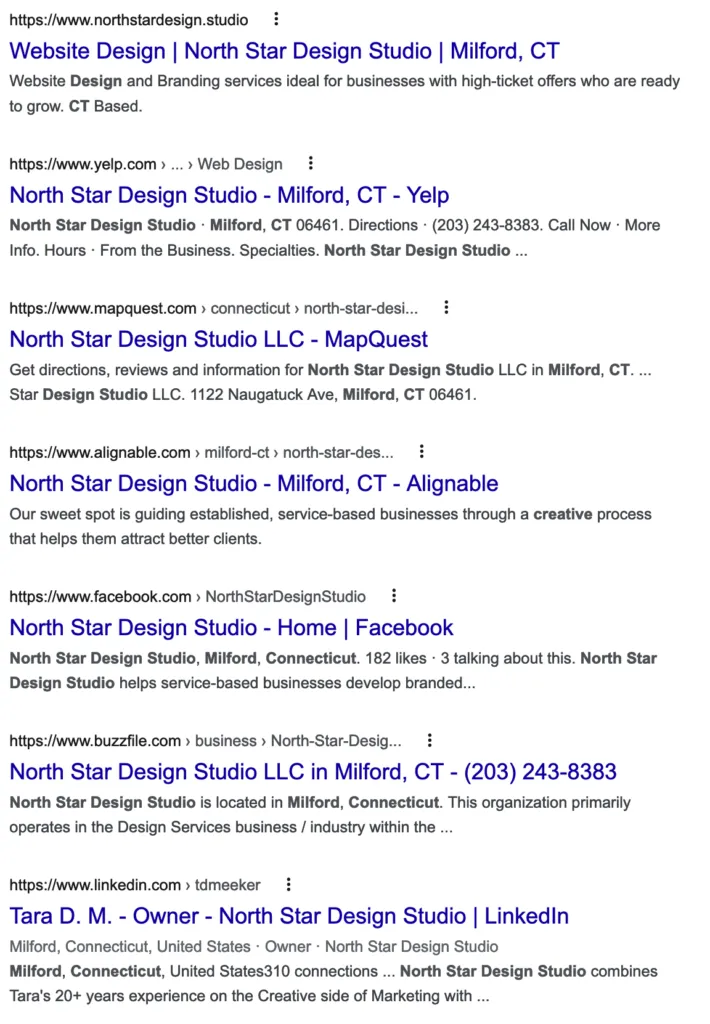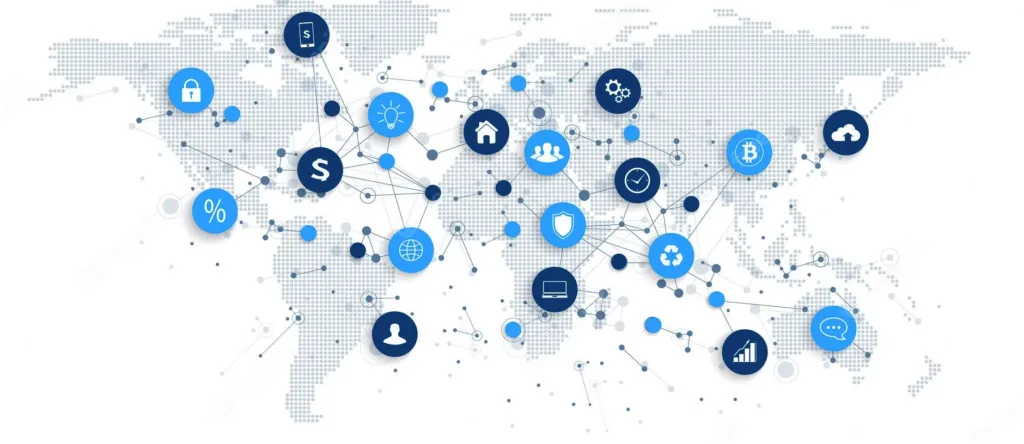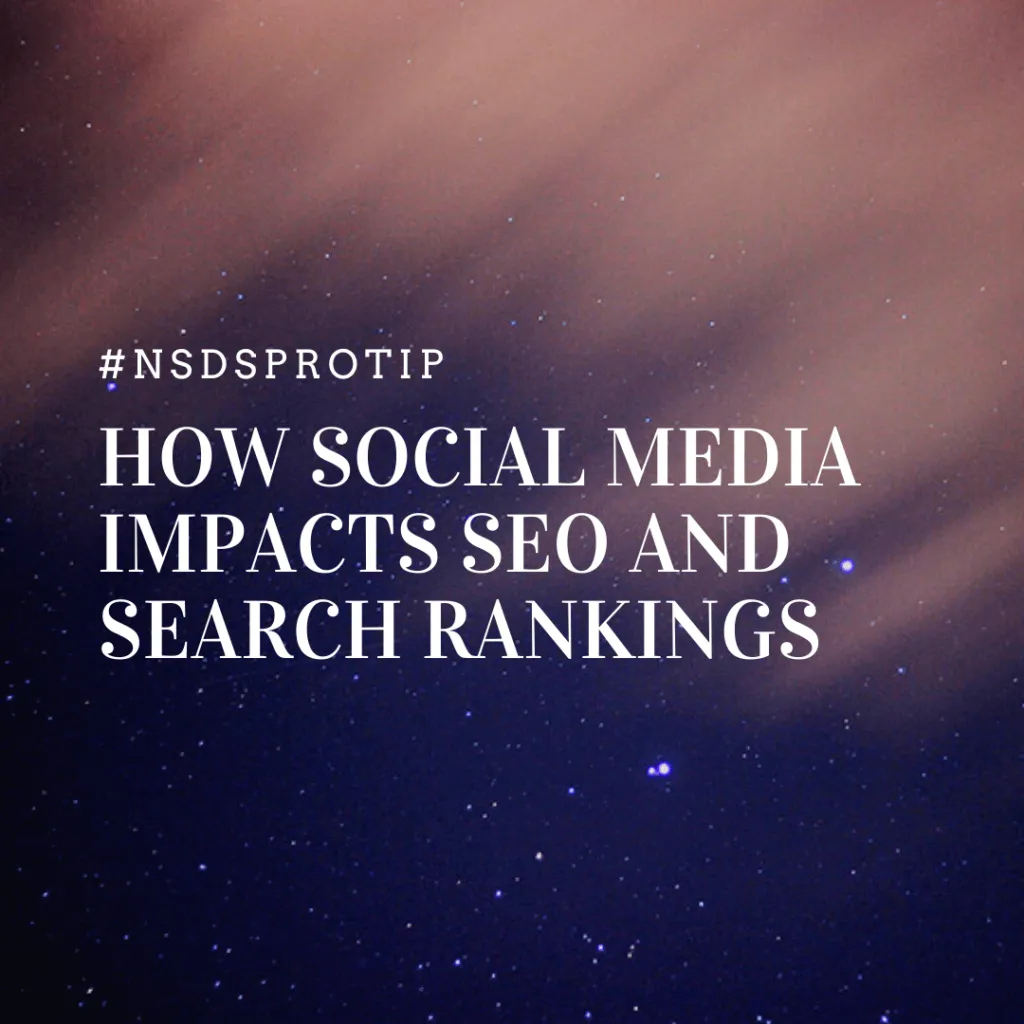Boost your online presence through effective Social Media SEO
Most business owners are aware of the value of social media in promoting their business. However, they might consider Social Media SEO as a separate channel from the rest of their marketing efforts. It’s true that a website’s rankings are not directly impacted by social profiles but social media can help. SM platforms can be used for content promotion and crafting a brand identity that attracts more users (site traffic) and sales (conversions).

Clients ask plenty of questions about the benefits of social media and how it can help boost website traffic. Having more SM followers doesn’t mean higher Google rankings (sorry, internet celebrities). But online customers consider factors like brand identity, customer engagement, and social proof before making a purchase decision. One could say that digital spaces like your website and Google My Business prove that your business is legit. While active and engaging social media profiles prove that you’re paying attention.

The simple SEO recipe for online marketing (higher ranking=more customers) ignores the buyer’s journey and the role of social media in it. I myself usually follow this course prior to contacting and service provider:
Google Search > Read Some Reviews > Check FB/Yelp/Angi > Peak at website
Scan for pricing mentions > Double check Google again for alternatives > Contact/Buy.
And chances are good that your own customer journey may look the same. Regardless of the stage of business, one needs to follow a holistic approach to online marketing. One where social media and SEO strategies work together to attract more customers.
In the simplest sense, your online sales strategy is like organizing a birthday party, you need:
- A Delicious Cake = Great Website Content
- Lots of Snacks = Frequent Blog Posts
- Decorations for the Background = Good Backlinks
- Party Boosters = Active Social Media Accounts
- Better Ideas than the last party = Competitor Analysis and Keyword Research
Any of the above components, when implemented on their own, may not provide a substantial result. But if you combine a couple or, even better, put them all together, you can have a great party that leaves a great, lasting impression.
While we don’t manage SM accounts, the North Star team routinely set up social media accounts for our customers. We’ll also connect related integrations and feeds to the website, and automate the process of posting blog articles to different platforms. Because NSDS considers SM essential for branding, an SM audit is included during our discovery phase on most projects.
We also recognize the importance of having a consistent social media presence across all platforms. NSDS assists (or insists) owners in claiming profiles, discovering hidden ones, and getting them updated. We also design branded elements for SM like icons and hero images so our web design clients look consistent across platforms.
When a comprehensive and consistent social media presence is combined with a foundation-building SEO strategy, our clients are better positioned. They enjoy increased brand awareness, better social engagement, more social shares, and better search ranking.
How does social media help with SEO?
While it is true that social media isn’t exactly a ranking factor, its benefits can feed into SEO. Social media helps with Search Engine Optimization in the following ways:
1. Drives Traffic
The ultimate purpose of SEO is to push your website up higher in the search results (ideally to the top of the first page) so users see your listing first which should result in more clicks thru to your website (aka traffic). And the more quality ‘traffic’, the more likely search engines are to keep presenting you first to users. Improving your SEO Ranking is typically supported by cake, snacks, and lots of decorations. However, improving your website’s rank isn’t the only technique to increase visitors (traffic) to your site.
You may drive a lot more traffic to your website by adopting an active and creative approach to social media management and posting the information that your audience wants to see.
Currently, 3.78 billion social media users worldwide spend an average of 2 hours and 25 minutes every day on social media. With these numbers, we know potential customers will interact with your brand through your social media profile.
One of the best ways to increase your rankings is to regularly post great, new content to your site. But we’re playing the long game as search engines want to see new content consistently so it doesn’t help to post 10 blog articles all at once. It’s better to dribble them out steadily. Because of this, an on-page SEO effort can take months to begin producing results. And, while the wait is worthwhile, you may not receive the traffic you require right now.
That’s why if you’re just starting with SEO (and we all have to start somewhere), social media content can help you get traffic faster than search engines.
2. Social Media Profiles Rank in Search Engine Results
Your social media profiles are not confined to social media alone; they appear in Google search results as well. Especially for branded terms, your social accounts may appear alongside your website. For example, take a look at how NSDS social media pages rank just below the website in branded keyword research.

Why not take advantage of additional opportunities to rank for branded searches through social SEO?
People who are looking for your business (brand) are already interested in the general services/product you offer. We call these problem and solution aware customers, they already know what their problem is and the solutions available, they’re now just trying to decide on a service provider.
Having active and engaging social media profiles could be the ranking signal (ranking factor) you need to get more traffic to your website and capture these top-tier customers who are literally looking for your exact product and service.
3. It improves your content reach
Social media helps to improve your content reach. Once you’ve created a blog post, its longevity is determined by search engines. Having a strong social media presence enables you to bypass these search engines, control distribution, and extend the life of your work by reposting it in new ways whenever you want.
Another advantage of publishing on social media is the ability to use your content to target certain audiences, thereby pre-qualifying them for your business. Again, generating interaction and click-through on these platforms may not have a direct influence on SEO. But it can increase the number of eyes and ears on your content, which may have an indirect impact on ranking metrics such as website traffic, backlinks, and domain authority.
#NSDSProTip
No one ‘owns’ their social media profiles. Because they’re mostly free, we don’t really have the final ‘say’ over anything related to them either. Social media profiles are simply a platform for distribution (much the same way a newspaper is). This is why we advise clients to post articles/blogs to their own site first and then repost them out to SM. This is recommended in lieu of using built-in publishing tools like LinkedIn provides. This way, you’ve full ownership of your content and can manage distribution from your own tools. If you’re going to put all the work into writing blogs, post them to your website first and then distribute them out to sm.
4. Social Media Profiles Build Trust and Improve Brand Recognition
Social profiles humanize your brand and help increase your sales. Businesses that do not have a social media strategy limit their ability to convert new customers. While businesses with active social media profiles reach their target audience, report better sales, and generate more social media signals. According to a GlobalWebIndex survey reported by SearchEngineWatch, 71% of online shoppers tend to buy a product after seeing it advertised on social media.
#NSDSProTip
Our top tip: hire professionals. While NSDS builds structural foundations for SM marketing and considers educating our clients on its importance a priority, we leave actual SM strategizing up to professionals like the Janice Christopher Marketing Agency team who are specialists and offer free consultations. If you’re looking to pursue an SM strategy and ready to allocate a monthly budget, I recommend checking them out. They have an amazing platform for managing SM and have both a DIY and Done For You pricing structure.
Social profiles are a must-have for all businesses. People expect to see reputable brands on social media. Like a broken or outdated website, consumers may see poor or non-existent social profiles as a red flag.
#NSDSProTip
Perhaps pre-covid, a business could ‘get away’ with leaving their SM untouched for weeks or months at a time (not really, but I’m being generous here). But with so many businesses shuttering doors, an inactive (or nonexistent) SM profile could leave prospective clients to assume you’re out of business!
Social media can help boost your online presence when you post often. Any marketer will tell you that it takes 7+ touchpoints with a client to move the needle on ‘conversion’. So popping up in feeds regularly is how you’ll increase likes, views, and clicks (aka optimizing). Posting regularly also allows you to humanize your brand and give it a voice where customers see themselves in you.
With SM you have the opportunity to discuss what sets you apart from the crowd. You can engage directly on a 1-to-1 basis with others who want to learn more. And, perhaps of most benefit, you can address concerns in real-time. For instance, say there’s been a major business or industry event that customers need to know about? Your business has to suddenly change its hours or a new regulation is about to go into effect that will affect your customers.
SM is an AMAZING way to get important updates in front of customers fast. Being the first to say “Hey, here is this really important update and why it’s important to you!” Is a very powerful way to deliver added value to customers and set yourself apart from the competition. It says you’re interested in ‘relationships’ vs just ‘transactions’ which builds trust and loyalty.

5. Social Media Helps with Local SEO
Social media has a positive impact on your local SEO efforts in a variety of ways. As you may be aware, your NAP (your company’s name, address, and phone number) plays an essential part in local search rankings. Google will consider your business more legitimate if you keep consistent NAP information across all of your social profiles, listings, and website(s). This can help you rank higher in local search results.
#NSDSProTip
I often see a hesitation from businesses headquartered in home offices to post their address online. There are nuanced ways you can address (no pun intended) the NAP quandary this presents but the easiest way is to fill in your town and city (vs entire street address) and be sure to use the ‘areas serviced’ feature whenever available. I have an awesome #NSDSPROTIP in this article about how to circumvent the address (NAP) issue specific to Google My Business.
Certain social media networks allow you to geotag your stories and posts (Facebook is particularly good for this). This is an excellent approach to increasing your presence within a local audience, allowing you to broaden your reach. Instagram and Youtube users, for example, can search for content that has been geotagged to a certain place. This allows you to target specific groups of people and pre-qualify them.

6. Backlinks
Sharing your material on social media isn’t only about increasing website traffic. More views on your material increase the likelihood of someone linking to it (aka backlinking), you can in essence become a resource other service professionals use to help their customers (and that is great SEO juice).
Backlinks are an important aspect of SEO. They demonstrate to search engines that other people value the material on your website. If a piece of content is useful to users, it will be ranked higher.
You could have fantastic content that deserves backlinks, but you won’t receive them if it goes ignored so posting your content on social media can get you more exposure. Even if you don’t have a significant number of followers on social media, your content can spread quickly. It only takes one person to link back to you for additional people to see it, and social media is a terrific place to start.
#NSDSProTip
A great way to get traction on your content is to leverage your network. If your business group has a private group page (and the rules allow for it), post links to content (like blog articles) there and specifically ask the group to share it within their own personal and professional networks. Also, join a few industry-specific groups (say on Facebook) and ‘lend’ yourself as a thought leader when your peers have questions. This can prompt industry peers to lean into you for support and spread your content to their own networks.
7. Social Profiles Help in SEO
When more people share content on social media, it generates social signals that indicate that your posts are valuable to the audience. Research by cognitive SEO revealed that social media shares on selected platforms are vital signals which are used by search engines while ranking a website. Google Webmaster and Trends Analyst Garry Illyes note that Google ranks social media profiles in search results and they are important from an SEO perspective. So social media doesn’t directly impact SEO but improves rankings indirectly.
How to incorporate social media into an SEO strategy?
The following are some of the tips to improve your SEO through improved social media profiles:
- Produce high-quality content.
Keyword stuffing is a thing of the past. Post-high-quality, relevant content for better engagement. Some marketers post content every other day. Instead, take time to research your material and post in-depth content that truly benefits your readers, and post on a regular schedule you can maintain, maintenance is key. Again, search engines want to see a steady stream of new content, not big data dumps every couple of months.
- Post better content than your competitors.
An important tip is to post better content than your competitors to get more visibility. The strategy is called the skyscraper technique and focuses on creating content that outperforms and outranks your competition. Such content will be able to rank for a variety of keywords. As it is more valuable, it will get more quality backlinks.
- Make sharing your content easier.
Social media allows people to engage with your content and increase its reach. The calls to action help people to easily share your content and convey it to other people. A great CTA lead-in might be something like, “Share this post with <ClientType> you know who is struggling with <Problem> and looking for a <Solution>. This just might make their day!”
- SEO for Social Media Sites
Optimize your social media sites! Start by identifying measurable goals, such as reaching more people (audience reach), increasing engagement, sales (conversions), etc. Next, fill out your profiles completely and include relevant keywords (customers might use to find your specific services), location, and your business hours.
Visuals are an important part of marketing communication so be sure to add images to all your profiles and do it often. To make the most of your images, it is important to optimize them by adding descriptions, links, and even keywords into alt tags when a platform allows. It’s also a good idea to reduce image size for faster loading and create compelling captions with keywords.
Conclusion
If you aren’t using social media, chances are you aren’t doing SEO correctly as SM is a key component of a solid SEO strategy. You may even be hurting yourself with search engines whose algorithms thrive on putting verified content in front of users. To say that online markets are ‘competitive’ would be an understatement but those of us in smaller, more niche markets can still make a big impact for ourselves by leveraging free social media platforms.
Simply having a Facebook or Twitter account isn’t enough though, you have to USE THEM too! Attract followers, develop links, enhance your brand’s image, and engage with your local community authentically and on a consistent basis. There are a lot of ‘best practices’ to follow but the best approach, IMO, is to develop novel and unique ways to get your message out there. Being specific and available is second only to being genuine because SM is about building relationships. So go ahead, get out there and build some relationships!
Key Article Definitions:
Backlinks: Links from other websites to your own are called ‘backlinks’. Sometimes they’re referred to as inbound links as well.
Content: Site content refers to any of the text, images, audio or video material on your website, social media page or any other online profile. If you’ve been published or featured on websites you do not own, that material may also fall under the umbrella of ‘content’.
Customer Journey: A Customer’s Journey is the sum of all steps any customer took before buying from you (in the ‘olden days’ this was sometimes called the marketing funnel).
Keyword Stuffing: The antiquated practice of loading up a website page (or code) with a gratuitous amount of keywords or search terms in an attempt to manipulate search engine algorithms. Aside from being ineffectual these days, search engines can actually tell when a site is doing this and will ‘downgrade’ a site as a result.
Optimize: Optimizing in web terms means the same as it does anywhere else, ‘to make the most out of or use to best effect’.
Ranking Signal: Better understood as a “ranking factor”, this refers to the characteristics of a site (or profile) that a search engine might consider to calculate your rankings in results. Adding content to your website (or profiles) on a regular basis that increases site traffic will create positive ranking signals.





